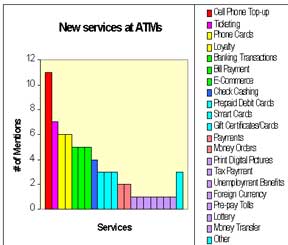News
In search of the next "killer app"
It's no secret that ATM deployers would kill for a new killer app. Based on early experiments, consultant Peter Kulik says that targeted niche services seem to offer the most promise. Kulik has identified three characteristics that he says any new ATM service must possess to be viable.
May 22, 2002
Cash is the "killer app" for ATMs, and has driven their proliferation around the world like Lotus 1-2-3 did for the first personal computers. But, like the PC industry, the ATM industry is now seeking its next "killer app."
 |
Peter Kulik |
ATM deployers around the world are experimenting with new interactions ranging from self-service coupons to maps, from mobile phone top-up to ATM advertising.
But, what is the next "killer app?" KLCI Research Group's worldwide "ATM Trends and Futures" study looked at this question -- with some surprising results.
Based on input from 37 deployers around the world, cell phone top-up leads the list, consistent with the recent announcement by Euronet Worldwide and Abbey National plc to offer top-up for Orange phones in the UK. (See related story Euronet to offer mobile recharge in the UK at Abbey National ATMs).
The next most commonly mentioned transactions were ticketing, phone card dispensing and loyalty schemes. Overall interest in new ATM services was quite high across all countries and regions surveyed; some representative comments from participating deployers included:
- "Will be a case of trying to rack up other revenue streams"
- "Always looking for new revenue opportunities"
- "Plan to add additional services… addresses lower end of the market"
- "Will (use the ATM as a) distribution channel for other services, deploy in convenience stores, other good locations"
- "Most people in this business are looking for new ways to open up new markets"
- "All of us want to see extra revenue… the market will continue to struggle for new revenue"
- "Beginning to see larger groups move in the direction of alternative revenue sources"
However, new ATM services can be a bit of a chicken-and-egg problem, with deployers willing to roll out new services once these services have been proven viable and repeatable, but not willing or able to invest the up-front cost to be the first to prove viability of a new service.
We found the most interest in new services on a niche basis - services specifically targeted at a particular niche that matches the user demographics of a specific ATM. This approach is perceived as having lower up-front investment and better potential return on investment due to higher per-ATM transaction volume (if the niche targeting is successful).
 |
One example: automating the money order transaction in convenience stores where large numbers of money orders are sold manually today.
Research identified the following three characteristics that a new ATM service must have to be viable. Any new service should meet the following three conditions:
1. Have value to the consumer - if the consumer doesn't use a service, it will not be successful.
2. Have value to the site owner (i.e. merchant, convenience store, etc.) - could be just an increase in transaction fee income, but even better is an increase in in-store income.
3. Keep it short - long transactions defeat the fundamental motivation of installing convenience ATMs; i.e. quick access to cash.
As an example considering these three characteristics, loyalty seems to offer promise for ATMs in convenience locations; loyalty programs have value to the consumer (such as discounted goods), value to the site owner (return visits and purchases by consumers), and do not add significantly to transaction time. Indeed, Euronet-Poland has been successful with a low-tech approach to loyalty, printing McDonald's vouchers as part of transactions.
So, what is the next "killer app" for ATMs? The best indication we have today is for a suite of targeted niche services - but time (and consumers) will tell!
KLCI Research Groupis a market research firm with focus on the Financial Services, ATM, and Kiosk industries. Recent studies have included "ATM Industry Operations and Cost Benchmark," "Entry-Level ATM Trends and Futures," "Reducing Costs of ATM Cash" and the Kiosks.org RFI Analysis.
With more than 15 years experience in the financial services industry,Peter Kulikhas published and spoken widely on topics ranging from ATM Operations to Outsourcing to CRM. He is Managing Director of KLCI Research Group, and focuses on research for banking and independent ATM deployment. Some recent clients have included CIBC, Halifax plc, NCR, and RBC Royal Bank; he also spoke on CRM in the ATM Channel at the 2001 BAI RDS conference.









